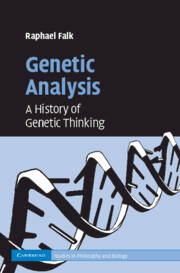Book contents
- Frontmatter
- Contents
- List of figures
- Acknowledgments
- Introduction
- PART I FROM REPRODUCTION AND GENERATION TO HEREDITY
- PART II FAKTOREN IN SEARCH OF MEANING
- PART III THE CHROMOSOME THEORY OF INHERITANCE
- PART IV GENES AS THE ATOMS OF HEREDITY
- PART V INCREASING RESOLVING POWER
- PART VI DEDUCING GENES FROM TRAITS, INDUCING TRAITS FROM GENES
- PART VII WHAT IS TRUE FOR E. COLI IS NOT TRUE FOR THE ELEPHANT
- Concluding comments
- Bibliography
- Index
PART III - THE CHROMOSOME THEORY OF INHERITANCE
Published online by Cambridge University Press: 07 August 2009
- Frontmatter
- Contents
- List of figures
- Acknowledgments
- Introduction
- PART I FROM REPRODUCTION AND GENERATION TO HEREDITY
- PART II FAKTOREN IN SEARCH OF MEANING
- PART III THE CHROMOSOME THEORY OF INHERITANCE
- PART IV GENES AS THE ATOMS OF HEREDITY
- PART V INCREASING RESOLVING POWER
- PART VI DEDUCING GENES FROM TRAITS, INDUCING TRAITS FROM GENES
- PART VII WHAT IS TRUE FOR E. COLI IS NOT TRUE FOR THE ELEPHANT
- Concluding comments
- Bibliography
- Index
Summary
Cytology … merely established the zygote to be double with respect to the gametes. It was, however, discoveries like that of Mendel and his followers, which show that the gamete's simple nature corresponds also with respect to heredity.
Johannsen (1926, 432)Already in 1900 Correns suggested that Mendel's “numerical ratio 1:1 strongly suggests that the separation occurs during a nuclear division, the reduction division of Weismann” (Correns, in Stern and Sherwood, 1966, 127). It was, however, only after the establishment of Mendel's laws that cytologists came to share a set of common assumptions which led them to agree on what they saw under the microscope and eventually to accept the link between chromosomes and Mendelian factors. Chromosome continuity and integrity and their specificity were derived from Boveri's experiments; chromosomes' simulation of multi-factorial Mendelian segregation further supported their role in inheritance, as Wilson and his associates indicated in studies of sex-determination in various insect species. But the behavior of chromosomes could not be simply observed; it had to be interpreted: were these just certain other structure-properties that obeyed the Mendelian laws of segregation or were these elements that causally determined the observed Mendelian laws of segregation? The establishment of the distinction between genotype and phenotype, overcoming the preformationist notion of unit character, was crucial for such an examination.
Morgan's discovery of a correlation between the pattern of inheritance of a Mendelian factor of Drosophila and that of its sex-chromosome suggested a causal relationship, but only the finding that the inheritance of several independent Mendelian factors was similarly correlated with sex-chromosomes allowed the hypothesis that the chromosome was the causal mediator of inheritance.
- Type
- Chapter
- Information
- Genetic AnalysisA History of Genetic Thinking, pp. 75 - 76Publisher: Cambridge University PressPrint publication year: 2009



